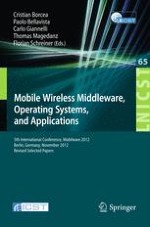2013 | Buch
Mobile Wireless Middleware, Operating Systems, and Applications
5th International Conference, Mobilware 2012, Berlin, Germany, November 13-14, 2012, Revised Selected Papers
herausgegeben von: Cristian Borcea, Paolo Bellavista, Carlo Giannelli, Thomas Magedanz, Florian Schreiner
Verlag: Springer Berlin Heidelberg
Buchreihe : Lecture Notes of the Institute for Computer Sciences, Social Informatics and Telecommunications Engineering
